Related Research Articles
This is a list of aviation-related events from 1943:
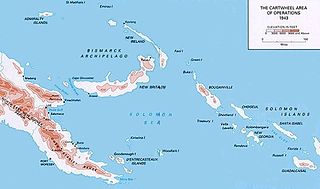
Operation Cartwheel was a major military operation for the Allies in the Pacific theatre of World War II. Cartwheel was an operation aimed at neutralising the major Japanese base at Rabaul. The operation was directed by the Supreme Allied Commander in the South West Pacific Area (SWPA), General Douglas MacArthur, whose forces had advanced along the northeast coast of New Guinea and occupied nearby islands. Allied forces from the South Pacific Area, under Admiral William Halsey, advanced through the Solomon Islands toward Bougainville. The Allied forces involved were from Australia, the Netherlands, New Zealand, the US, and various Pacific Islands.
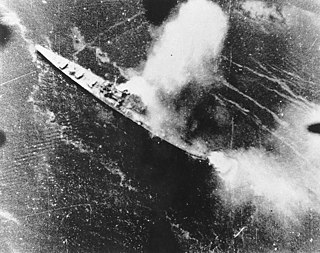
The bombing of Rabaul in November 1943 was an air attack conducted by the Allies of World War II upon a cruiser force at the major Japanese base of Rabaul. In response to the Allied invasion of Bougainville, the Japanese had brought a strong cruiser force down to Rabaul from Truk, their major naval base in the Caroline Islands about 800 miles north of Rabaul in preparation for a night engagement against the Allied supply and support shipping. Allied carrier- and land-based planes attacked the Japanese ships, airfields, and port facilities on the island of New Britain to protect the Allied amphibious invasion of Bougainville. As a result of the Rabaul raids, the Japanese naval forces could no longer threaten the landings. The success of the raid began to change the strongly held belief that carrier-based air forces could not challenge land-based air forces.

The Battle of Rabaul, also known by the Japanese as Operation R, an instigating action of the New Guinea campaign, was fought on the island of New Britain in the Australian Territory of New Guinea, from 23 January into February 1942. It was a strategically significant defeat of Allied forces by Japan in the Pacific campaign of World War II, with the Japanese invasion force quickly overwhelming the small Australian garrison, the majority of which was either killed or captured. Hostilities on the neighbouring island of New Ireland are usually considered to be part of the same battle. Rabaul was significant because of its proximity to the Japanese territory of the Caroline Islands, site of a major Imperial Japanese Navy base on Truk.

The New Georgia campaign was a series of land and naval battles of the Pacific Theater of World War II between Allied forces and the Empire of Japan. It was part of Operation Cartwheel, the Allied strategy in the South Pacific to isolate the Japanese base around Rabaul. The campaign took place in the New Georgia Islands in the central Solomon Islands and followed the Allied capture of the Russell Islands. The main fighting took place on New Georgia itself, although significant actions also took place around the island chain throughout the campaign.

The New Guinea campaign of the Pacific War lasted from January 1942 until the end of the war in August 1945. During the initial phase in early 1942, the Empire of Japan invaded the Territory of New Guinea on 23 January and Territory of Papua on 21 July and overran western New Guinea beginning on 29 March. During the second phase, lasting from late 1942 until the Japanese surrender, the Allies—consisting primarily of Australian forces—cleared the Japanese first from Papua, then New Guinea, and finally from the Dutch colony.
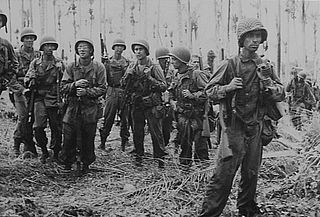
The New Britain campaign was a World War II campaign fought between Allied and Imperial Japanese forces. The campaign was initiated by the Allies in late 1943 as part of a major offensive which aimed to neutralise the important Japanese base at Rabaul, the capital of New Britain, and was conducted in two phases between December 1943 and the end of the war in August 1945.
Vunakanau Airfield was an aerodrome located near Vunakanau, East New Britain, Papua New Guinea. The airfield was constructed as a Royal Australian Air Force aerodrome and consisted of an unpaved single runway during World War II. The airfield was captured during the battle of Rabaul in 1942 by the Imperial Japanese and was extensively modified and expanded. Vunakanau was later neutralized by Allied air bombing in May 1944.

The Battle of Munda Point was a battle in World War II between American and Japanese forces from 22 July to 5 August 1943 during the New Georgia campaign in the Solomon Islands in the Pacific War. The battle took place following a landing by U.S. troops on the western coast of New Georgia from Rendova Island, as part of an effort to capture the Japanese airfield that had been constructed at Munda Point. This advance had become bogged down, and while the Allies brought forward reinforcements and supplies, the Japanese had launched a counterattack on 17–18 July. This effort was ultimately unsuccessful, and afterwards U.S. forces launched a corps-level assault to reinvigorate their effort to capture the airfield. Against this drive, Japanese defenders from three infantry regiments offered stubborn resistance but were ultimately forced to withdraw, allowing U.S. forces to capture the airfield on 5 August. The airfield later played an important role in supporting the Allied campaign on Bougainville in late 1943.

Uzuki was one of twelve Mutsuki-class destroyers built for the Imperial Japanese Navy (IJN) during the 1920s. During the Pacific War, she participated in the Battle of Wake Island in December 1941 and the occupations of New Guinea and the Solomon Islands in early 1942.
Lark Force was an Australian Army formation established in March 1941 during World War II for service in New Britain and New Ireland. Under the command of Lieutenant Colonel John Scanlan, it was raised in Australia and deployed to Rabaul and Kavieng, aboard SS Katoomba, MV Neptuna and HMAT Zealandia, to defend their strategically important harbours and airfields.
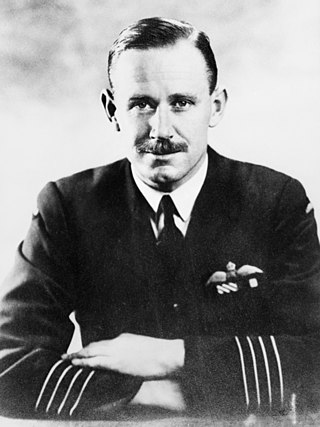
John Margrave Lerew, DFC was an officer and pilot in the Royal Australian Air Force (RAAF) during World War II, and later a senior manager in the International Civil Aviation Organization (ICAO). As commander of No. 24 Squadron, based in New Britain, he became famous in the annals of Air Force history for his irreverent response to orders by headquarters in Australia during the Battle of Rabaul in January 1942. After his squadron was directed to assist in repelling the invading Japanese fleet with its one serviceable bomber, and to keep its damaged airfield open, Lerew signalled headquarters with the ancient Latin phrase supposedly used by gladiators honouring their Emperor: "Morituri vos salutamus". He also defied an order to abandon his staff, and organised their escape from Rabaul.
Vunakanau is situated on a plateau just outside Rabaul, Papua New Guinea. Vunakanau Airfield was used in World War II. In the 1970s Vunakau was proposed to be used as the new airstrip replacing Rabaul however this did not eventuate.
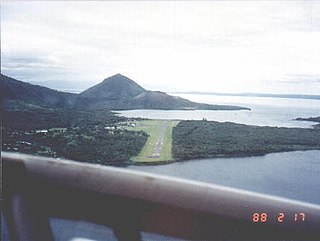
Lakunai Airfield, later known as Rabaul Airport, was an aerodrome located near Rabaul, East New Britain, Papua New Guinea. It was located at the foot of Tavurvur volcano, near Matupit Island. The airport was destroyed by the 1994 eruption that destroyed the town of Rabaul and subsequently a new airport was built and opened at Tokua, on the opposite side of the Rabaul caldera. The former airport was located at 04°13′S152°11′E.
The Fourth Air Army was a land-based aviation force of the Imperial Japanese Army. Formed in Rabaul in June 1943, consisting of the 6th and 7th Air Divisions. The air army was responsible for covering the Solomon Islands, Dutch New Guinea and the Territories of Papua and New Guinea areas of operations. The headquarters was at Rabaul. Disestablished in January 1945.
Tobera airfield was an aerodrome located near Tobera, near Keravat, East New Britain, Papua New Guinea. The airfield was constructed by the imperial Japan during World War II. Tobera was later neutralized by Allied air bombing from 1944. The airfield was abandoned after the cessation of hostilities.

Kerevat Airfield was an aerodrome located near Kerevat, East New Britain province, Papua New Guinea. Situated on the northern coast, it was 13 miles (21 km) south west of Rabaul. The airfield was constructed by the Imperial Japanese in World War II during September 1943. Kerevat Airfield was neutralized by Allied Powers' air bombing from 1944, who ran missions on the airfield between June 20, 1943, and May 16, 1944. The airfield was abandoned after the cessation of hostilities; however, the airstrip is still visible.
Borpop Airfield, also known as Huris Airfield, was an aerodrome located near Namatani, west of Borpop Harbour in New Ireland Province, Papua New Guinea. The airfield was built by the Imperial Japanese during World War II.
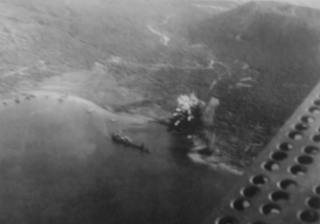
The neutralisation of Rabaul was an Allied campaign to render useless the Imperial Japanese base at Rabaul in eastern New Britain, Papua New Guinea. Japanese forces landed on Rabaul on 23 January 1942, capturing it by February 1942, after which the harbor and town were transformed into a major Japanese naval and air installation. The Japanese heavily relied on it, using it as a launching point for Japanese reinforcements to New Guinea and Guadalcanal. Throughout the Solomon Islands campaign, neutralizing Rabaul became the primary objective of the Allied effort in the Solomons.
Ro-100 was an Imperial Japanese Navy Ro-100-class submarine. Completed and commissioned in September 1942, she served in World War II, operating in the Solomon Islands, Rabaul, and New Guinea areas. She sank in November 1943 when she struck a mine during her seventh war patrol.
References
- Sakaida, Henry (1996). The Siege of Rabaul. St. Paul, MN, USA: Phalanx. ISBN 1-883809-09-6.
- Gamble, Bruce (2006). Darkest Hour: The True Story of Lark Force at Rabaul. St. Paul, Minnesota: Zenith Imprint. ISBN 0-7603-2349-6.